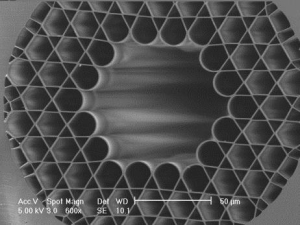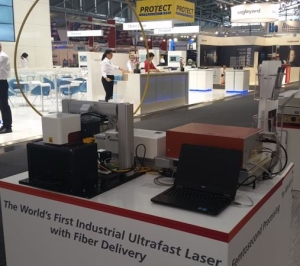By Eric Mottay
Technology breakthroughs can change the face of a whole industrial sector; in many cases unexpected discoveries drive unprecedented benefits for industrial applications. Let’s consider the adaptation of lasers into various industrial sectors and developments in laser technologies. The advent of solid-state lasers some 30 years ago, in a world dominated by gas lasers, brought unparalleled advantages, through the significant increase in efficiency gained by replacing flashlamps with semiconductor laser diodes and the development of high beam quality, high average power thin disk lasers.
The micro-manufacturing industry has experienced profound changes over the past decade, largely attributed to the increasing availability of industrial grade, high power ultrafast lasers. Another key contributing factor has been the heavy investment and development of associated beam delivery technologies. Many solid-state lasers used in industry today employ optical fiber beam delivery, enabling easy coupling to industrial robots, the ability to supply multiple workstation from a single high power laser source, and more generally, offering exceptional flexibility to production processes.
Ultrafast lasers, until now, have not been able to offer a fiber delivery solution to benefit from this manufacturing revolution. All ultrafast lasers used in industry today, use free-space beam delivery through a combination of mirrors, adding to the overall cost of ownership of the laser processing machine.
Ultrafast lasers used in industry are operated at extremely high powers making it extremely difficult to propagate the beam along the small core of an optical fiber. Not only do the high intensity pulses (that many ultrafast laser processes covet) damage traditional optical fibers used commonly with solid state lasers, the nonlinear effects generated severely degrade the spectral and temporal qualities of the beam, making the output beam unsuitable for practical use.
Industrial laser processing in micro-manufacturing requires a high beam quality and single transverse mode propagation to the work surface to meet strict precision targets in order to achieve the small feature sizes typical of micro-processing applications. The small core size of most single mode optical fibers severely restricts the beam size and the pulse energy. In addition, dispersion and nonlinear effects in the fiber core tend to degrade the spectral and temporal profile of the beam, creating undesirable effects.
Previous research efforts to overcome these basic limitations have experienced limited success: Large mode area, micro-structured fibers have increased the core size for single mode propagation. However, typical solid core optical fibers, for example glass, induce nonlinear effects which reduce the output energies available. Alternatively, hollow core fibers, propagating the beam in air or a neutral gas limit nonlinear effects. These, however, are available only with a very small core size, again limiting the output energy.
Things are about to change!
The recent development of Kagome optical fibers, introduces a new class of large core, hollow fibers. These fibers rely on a sophisticated propagation mechanism to prevent the propagation of higher order modes in the hollow core, thus preserving beam quality and limiting optical losses without degrading the host fiber. Extensive research and optimization efforts have been performed over the last few years, most notably by the group of Dr. Fetah Benabid at the University of Limoges, France.

Kagome fibers core size now reach more than 40 µm, allowing for high energy propagation. The core shape has been refined from almost circular to an optimized hypocycloidal shape. This shape confines the lowest order mode in the core, away from the struts which are one of the main sources of loss (Fig. 1).
Kagome fibers now exhibit an ideal set of specifications, paving the way for practical applications including:
- A hollow core to minimize dispersion and maintain ultrashort pulse duration
- A large mode area for high energy capability
- Possibility to use other gases than air for engineering flexibility
Practical demonstrations have outlined the enormous potential of Kagome fibers for industrial applications. For example, a laser beam with a pulse energy of 1 mJ and a pulse duration of 500 fs was sent into a 10 m long Kagome fiber, with a high transmission efficiency and virtually no change in pulse duration.[1] In another set of experiments, Kagome fibers have also demonstrated the capability to handle an average power in excess of 100 W. [2] Further, output pulse durations lower than 100 fs have been demonstrated through nonlinear pulse compression.

In 2015, an industrial micro-machining workstation with a fiber delivered femtosecond laser operating with high pulse energy was presented, spectators were delighted to see the system running live at the Munich Laser Exhibition (Fig. 2). The display generated a keen interest from industry leaders in microfabrication and consumer electronics manufacturing.
The growing availability of Kagome fibers will offer unprecedented design flexibility to the laser manufacturer, the system designer and the end user. The advantages Kagome fibers will bring to the industrial use of ultrafast lasers are being named as the next revolution in laser based technologies for industry, and brings excitement to a huge variety of manufacturing industries that demand high precision, industrial grade laser technology.
References
1.) B. Debord, M. Alharbi, L. Vincetti, A. Husakou, C. Fourcade-Dutin, C. Hoenninger, E. Mottay, F. Gérôme, and F. Benabid, “Multi-meter fiber-delivery and pulse self-compression of milli-Joule femtosecond laser and fiber-aided laser-micromachining,” Opt. Express 22, 10735-10746 (2014)
2.) E. Mottay, F. Guichard, G. Machinet, Y. Zaouter, and C. Hoenninger, “High energy and high average power optical fiber ultrafast beam delivery and compression,” in 2015 Conference on Lasers and Electro-Optics Pacific Rim, (Optical Society of America, 2015), paper 25D3_4.
Eric Mottay is President and CEO of Amplitude Systemes.





